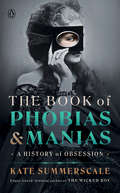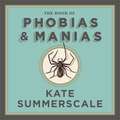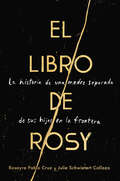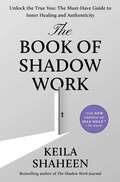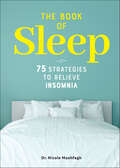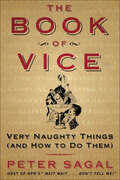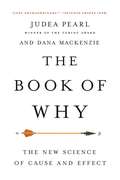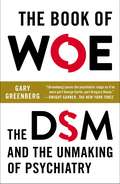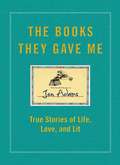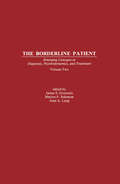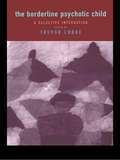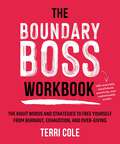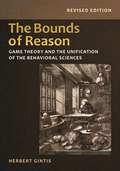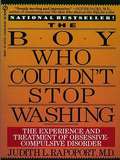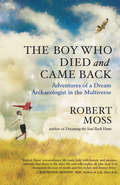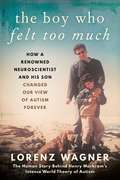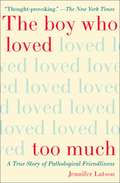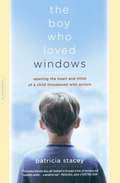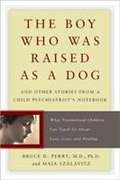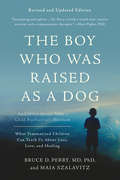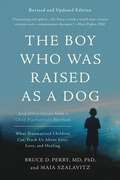- Table View
- List View
The Book of Phobias and Manias: A History of Obsession
by Kate SummerscaleFrom the winner of the Edgar Award and the Samuel Johnson Prize, a cultural history of &“everyday madness&”The Book of Phobias and Manias is a thrilling compendium of 99 obsessions that have shaped us all, the rare and the familiar, from ablutophobia (a horror of washing) to syllogomania (a compulsion to hoard) to zoophobia (a fear of animals). Phobias and manias are deeply personal experiences, and among the most common anxiety disorders of our time, but they are also clues to our shared past. The award-winning author Kate Summerscale uses rich and riveting case studies to trace the origins of our obsessions, unearthing a history of human strangeness, from the middle ages to the present day, and a wealth of explanations for some of our most powerful aversions and desires.
The Book of Phobias and Manias: A History of the World in 99 Obsessions
by Kate SummerscaleEver been struck dumb when speaking in public? You might be suffering from glossophobia. Do your book-buying habits verge on bibliomania? Do you recoil in arachnophobic horror at the sight of a spider - or twitch with nomophobia when you misplace your mobile phone?Our fears and compulsions often feel like part of our deepest selves - yet they're bound up in the currents of the world around us. This thrilling compendium of 99 phobias and manias, rare and familiar, delves into the obsessions that shape us all. Award-winning author Kate Summerscale takes us from the Middle Ages to the present day, using rich and riveting case studies to trace the links between the private and the public, thepersonal and the political.
The Book of Psychic Symbols: Interpreting Intuitive Messages
by Melanie BarnumA strong feeling, a remarkable coincidence, a strange dream . . . What may seem ordinary could actually be an important message from a deceased loved one, spirit guide, or your higher self. Open to a wealth of guidance and opportunities by learning how to recognize and interpret the signs and synchronicities all around us. Expand your awareness of the symbols in your life, strengthen your intuition, overcome challenges, and manifest your desires. This experiential guide includes:A dictionary of more than 500 traditional symbolsPractical exercises to develop your intuitive abilitiesGuidance in defining your own personal symbolsExplanation of how to use chakras and aurasStories and true-life psychic experiencesPraise:"Melanie Barnum offers a vast array of traditional interpretations sprinkled with her own insightful experiences, making The Book of Psychic Symbols an invaluable contribution to every psychic's library."—Elizabeth Harper, author of Wishing: How to Fulfill Your Heart's Desires
The Book of Rosy / El libro de Rosy (Spanish edition): La historia de una madre separada de sus hijos en la frontera
by Julie Schwietert Collazo Rosayra Pablo Cruz«[El libro de Rosy] ofrece esperanzas ante probabilidades desconcertantes». — Uno de los libros más anticipados del verano 2020 según la revista Elle«Una autobiografía inolvidable [...] que narra la lucha a la que se enfrentan muchas familias que son separadas en la frontera entre Estados Unidos y México». —Libro DESTACADO por Publishers Weekly«La inquietante y elocuente historia de una guatemalteca en búsqueda de una vida mejor». —Libro DESTACADO por KirkusUna historia conmovedora sobre dos madres marcadas por la crisis migratoria: una guatemalteca que ha sido separada de sus hijos y la estadounidense que la ayuda a reunirse con su familia.Cuando Rosayra Pablo Cruz tomó la desgarradora decisión de buscar asilo en Estados Unidos con sus dos hijos, sabía que la travesía sería difícil, peligrosa y probablemente mortal. Pero la violencia rampante en Guatemala era insostenible; Rosy sabía que su familia sólo sobreviviría si migraba al norte.Tras un peligroso viaje que los deja deshidratados, hambrientos y exhaustos, Rosy y sus hijos logran llegar a Arizona. Pero casi inmediatamente son separados a la fuerza por los oficiales gubernamentales del Departamento de Seguridad Nacional bajo la política «tolerancia cero». Rosy y Julie Schwietert Collazo, la fundadora de Immigrant Families Together (Familias Inmigrantes Juntas), la organización comunitaria creada para reunir a madres con sus hijos, cuentan su historia y desvelan las crueles condiciones de los centros de detención, la insoportable ansiedad que padeció Rosy al ser separada de sus hijos y cómo la Fe y el amor la ayudaron a sobrellevar sus momentos más oscuros. Un retrato insólito y cautivante de las consecuencias que las políticas inhumanas infligen sobre los inmigrantes que cruzan la frontera estadounidense y de los lazos inquebrantables de la familia, la Fe y la comunidad.«Un libro que evidencia la compasión de los desconocidos y revela que, en estos tiempos tan desconcertantes, las historias aún tienen el poder de potenciar nuestra empatía y comprensión. Esta historia te cambiará para siempre». —J. Courtney Sullivan, autora de Saints for All Occasions«El libro de Rosy es una crónica valiente sobre uno de los momentos más vergonzosos de la historia de los Estados Unidos». —Christopher Soto, autor de Sad Girl Poems
The Book of Shadow Work: Unlock the True You: The Must-Have Guide to Inner Healing and Authenticity
by Keila ShaheenBestselling author and &“empress of self-help&” (The Atlantic) Keila Shaheen pens the ultimate modern guide for you to tap into the hidden powers that lie within you and unlock the life of your dreams. Do you ever look in the mirror and wonder, is this all there is? Are you currently capturing your strongest talent and tapping your deepest joy? Are you showing up as the best version of yourself? Are you satisfied with your career, relationships, and goals, or are you missing out on what life might have to offer you? Shadow work is the key to answering these and other questions truthfully so you can make the life of your dreams a reality. Originally founded by psychologist Carl Jung, shadow work guides you beyond surface self-help, bringing you face-to-face with the unacknowledged parts of yourself—the emotions, memories, beliefs, and yes, even the shame that shapes how you experience life every day. This journey lifts the veil between who you present as on the outside and who you truly are—and have the potential to become—on the inside. In this transformative process, reimagined for a contemporary audience for the first time, you&’ll learn how to accept all of your parts—including the ones you have been conditioned to hide from others—and in doing so, uncover hidden strengths you&’d never even dreamed of. Shadow work is a soulful practice that will guide you to release past regrets, and feel at home, perhaps for the first time, within yourself. Experience valuable inner healing with this essential resource and discover: - How shadow work can help you discover hidden talents and realize your true potential. - How shadow work can connect you to your life&’s purpose. - How shadow work can help you find a supportive, aligned community. - How to navigate shadow work within important relationships. - How shadow work has manifested throughout history, and what it means for our collective future.
The Book of Sleep: 75 Strategies to Relieve Insomnia
by Nicole MoshfeghFall asleep, stay asleep, wake up rested—proven strategies for beating insomnia.Make your bed and actually sleep in it. The Book of Sleep provides dozens of quick, easy, and evidence-based strategies that are more effective and sustainable than sleep medication for people who suffer from insomnia.Based in CBT-I (cognitive behavioral therapy for insomnia), the techniques in this book were developed by a clinical psychologist who specializes in insomnia treatment. Find the relief you need and wake up feeling truly restored. A good night's sleep isn't just a dream anymore.The Book of Sleep includes:Stand-alone strategies—Each helpful strategy is complete by itself so you can pick this book up anywhere and find help.What's your sleep pattern?—Keep a daily log of the quantity and quality of your sleep so you can remember details that are helpful in addressing your insomnia.Sleep tight—From kicking caffeine to keeping cool, get pointers on how to properly set the stage for restful sleep.Rise and truly shine. Follow the 75 effective sleep methods in this book and get out of bed feeling your best.
The Book of Vice: Very Naughty Things (and How to Do Them)
by Peter SagalSomewhere, somebody is having more fun than you are.Orso everyone believes. Peter Sagal, a mild-mannered, Harvard-educated radio host—the man who puts the second "l" in "vanilla"—decided to find out if it's true. From strip clubs to gambling halls to swingers clubs to porn sets and back to the strip clubs (but only because he left his glasses there), Sagal explores what the sinful folk do, how much they pay for the privilege, and how exactly they got those funny red marks.
The Book of Why: The New Science of Cause and Effect
by Judea Pearl Dana MackenzieA Turing Prize-winning computer scientist and statistician shows how understanding causality has revolutionized science and will revolutionize artificial intelligence"Correlation is not causation." This mantra, chanted by scientists for more than a century, has led to a virtual prohibition on causal talk. Today, that taboo is dead. The causal revolution, instigated by Judea Pearl and his colleagues, has cut through a century of confusion and established causality--the study of cause and effect--on a firm scientific basis. His work explains how we can know easy things, like whether it was rain or a sprinkler that made a sidewalk wet; and how to answer hard questions, like whether a drug cured an illness. Pearl's work enables us to know not just whether one thing causes another: it lets us explore the world that is and the worlds that could have been. It shows us the essence of human thought and key to artificial intelligence. Anyone who wants to understand either needs The Book of Why.
The Book of Woe
by Gary GreenbergAuthor and psychotherapist Gary Greenberg charts the DSM's controversial history in a riveting book that is sure to spark debate among expert and casual listeners alike.
The Book of Woe
by Gary GreenbergFor more than two years, author and psychotherapist Gary Greenberg has embedded himself in the war that broke out over the fifth edition of the Diagnostic and Statistical Manual of Mental Disorders--the DSM--the American Psychiatric Association's compendium of mental illnesses and what Greenberg calls "the book of woe." Since its debut in 1952, the book has been frequently revised, and with each revision, the "official" view on which psychological problems constitute mental illness. Homosexuality, for instance, was a mental illness until 1973, and Asperger's gained recognition in 1994 only to see its status challenged nearly twenty years later. Each revision has created controversy, but the DSM-5, the newest iteration, has shaken psychiatry to its foundations. The APA has taken fire from patients, mental health practitioners, and former members for extending the reach of psychiatry into daily life by encouraging doctors to diagnose more illnesses and prescribe more therapies--often medications whose efficacy is unknown and whose side effects are severe. Critics--including Greenberg--argue that the APA should not have the naming rights to psychological pain or to the hundreds of millions of dollars the organization earns, especially when even the DSM's staunchest defenders acknowledge that the disorders listed in the book are not real illnesses. Greenberg's account of the history behind the DSM, which has grown from pamphlet-sized to encyclopedic since it was first published, and his behind-the-scenes reporting of the deeply flawed process by which the DSM-5 has been revised, is both riveting and disturbing. Anyone who has received a diagnosis of mental disorder, filed a claim with an insurer, or just wondered whether daily troubles qualify as true illness should know how the DSM turns suffering into a commodity, and the APA into its own biggest beneficiary. Invaluable and informative, The Book of Woe is bound to spark intense debate among expert and casual readers alike.
The Books They Gave Me
by Jen AdamsTHE GIFT OF A BOOK BECOMES PART OF THE STORY OF YOUR LIFE. Perhaps it came with a note as simple as "This made me think of you," but it takes up residence in your heart and your home. The Books They Gave Me is a mixtape of stories behind books given and received. Some of the stories are poignant, some snarky, some romantic, some disastrous--but all are illuminating. Jen Adams collected nearly two hundred of the most provocative stories submitted to the tumblr blog TheBooksTheyGaveMe.com to capture the many ways books can change our lives and loves, revealing volumes about the relationships that inspired the gifts. These stories are, by turns, romantic, cynical, funny, dark, and hopeful. There's the poorly thought out gift of Lolita from a thirty-year-old man to a teenage girl. There's the couple who tried to read Ulysses together over the course of their long-distance relationship and never finished it. There's the girl whose school library wouldn't allow her to check out Fahrenheit 451, but who received it at Christmas with the note, "Little Sister: Read everything you can. Subvert Authority! Love always, your big brother." These are stories of people falling in love, regretting mistakes, and finding hope. Together they constitute a love letter to the book as physical object and inspiration. Illustrated in full color with the jackets of beloved editions, The Books They Gave Me is, above all, an uplifting testament to the power of literature.
The Books They Gave Me: True Stories of Life, Love, and Lit
by Jen AdamsThis beautiful full-color treasury of stories about gift book-giving celebrates the enduring power of literature: stories of significant books people have received and what those books mean to them.THE GIFT OF A BOOK BECOMES PART OF THE STORY OF YOUR LIFE. Perhaps it came with a note as simple as "This made me think of you," but it takes up residence in your heart and your home. The Books They Gave Me is a mixtape of stories behind books given and received. Some of the stories are poignant, some snarky, some romantic, some disastrous--but all are illuminating. Jen Adams collected nearly two hundred of the most provocative stories submitted to the tumblr blog TheBooksTheyGaveMe.com to capture the many ways books can change our lives and loves, revealing volumes about the relationships that inspired the gifts. These stories are, by turns, romantic, cynical, funny, dark, and hopeful. There's the poorly thought out gift of Lolita from a thirty-year-old man to a teenage girl. There's the couple who tried to read Ulysses together over the course of their long-distance relationship and never finished it. There's the girl whose school library wouldn't allow her to check out Fahrenheit 451, but who received it at Christmas with the note, "Little Sister: Read everything you can. Subvert Authority! Love always, your big brother." These are stories of people falling in love, regretting mistakes, and finding hope. Together they constitute a love letter to the book as physical object and inspiration. Illustrated in full color with the jackets of beloved editions, The Books They Gave Me is, above all, an uplifting testament to the power of literature.
The Borderline Patient: Emerging Concepts in Diagnosis, Psychodynamics, and Treatment (Psychoanalytic Inquiry Book Series #Vols. 6 & 7)
by Marion F. Solomon James S. Grotstein Joan A. LangThis volume focuses on treatment issues pertaining to patients with borderline psychopathology. A section on psychoanalysis and psychoanalytic psychotherapy (with contributors by V. Volkan, H. Searles, O. Kernberg, L. B. Boyer, and J. Oremland, among others) is followed by a section exploring a variety of alternative approaches. The latter include psychopharmacology, family therapy, milieu treatment, and hospitalization. The editors' concluding essay discusses the controversies and convergences among the different treatment approaches.
The Borderline Psychotic Child: A Selective Integration
by Trevor LubbeThe Borderline Psychotic Child reviews the history and evolution of the borderline diagnosis for children, both in the USA and the UK, bringing the reader up to date with current clinical opinion on the subject. Using a range of clinical case studies, the book attempts to harmonise US and UK views on borderline diagnosis in the light of new developments in theory at The Menninger Clinic, The Anna Freud Centre and The Tavistock Clinic. Providing an introduction to the borderline concept, and a systematic overview of current theoretical thinking and clinical practices from leading practitioners in the field, The Borderline Psychotic Child will make informative reading both for professionals and students in the field of child analysis.
The Boundaries Workbook: Exercises to Help You Set Healthy Boundaries and Improve Your Relationships
by Jake MorrillSet and maintain clear boundaries in every facet of your life Healthy boundaries define what you're willing to accept from others—and yourself. But learning to speak up for your needs and say no without feeling guilty takes some practice. This workbook offers insights and exercises to help you set, communicate, and uphold clear and consistent boundaries—so you can enjoy more rewarding relationships and start living the life you truly want.What sets this boundaries book apart:The basics of boundary-setting—Understand your needs, find freedom from limiting beliefs about yourself, and create boundaries that support your overall well-being.An array of engaging exercises—Explore writing prompts, actionable scripts, and mindfulness activities that help you maintain your boundaries and practice self-care.Additional support—Complete this workbook on its own or in conjunction with The Boundaries Journal for extra guidance and self-reflection.Learn how to set realistic limitations and prioritize your well-being with The Boundaries Workbook.
The Boundary Boss Workbook: The Right Words and Strategies to Free Yourself from Burnout, Exhaustion, and Over-Giving
by Terri ColeFrom boundary expert Terri Cole comes an empowering workbook featuring a wide variety of new practices, exercises, and encouragement.Our culture is finally recognizing the importance of having and maintaining strong personal boundaries. But were you ever taught exactly how to set healthy boundaries? Fortunately, you don't have to figure it out for yourself. Following on the runaway success of her book Boundary Boss, Terri Cole presents a practice-packed guide to help you establish the robust boundaries that are essential for an empowered and deeply satisfying life.The Boundary Boss Workbook greatly expands on the transformational tools Cole introduced in her debut book. You'll start with the essential truths about boundaries and how they operate, then dive straight into potent exercises ― including assessments, scripts, mindfulness, embodiment, gratitude, celebration and more. Here you'll explore:* The importance of boundaries and how they affect every part of your life* Self-assessment quizzes to identify your preferences, desires, limits, and deal-breakers* Your self-care tool kit ― meditations, reflections, and empowering practices * Getting proactive ― how to anticipate and prepare for boundary-setting situations* Boundary scripts ― creating the right words in your own voice for asserting boundaries * Internal boundary practices to shift your self-talk, habits, and unconscious behaviour * Establishing and upholding new rules for healthy, authentic and lasting relationshipsBoundary work takes intention and commitment―but the results are worth it. 'Drawing healthy boundaries is one of the highest expressions of self-love,' says Cole. 'When you do, every part of your life will blossom. You'll become more empowered in all your relationships ― especially the one you have with yourself.'
The Bounds of Reason: Game Theory and the Unification of the Behavioral Sciences - Revised Edition
by Herbert GintisGame theory is central to understanding human behavior and relevant to all of the behavioral sciences—from biology and economics, to anthropology and political science. However, as The Bounds of Reason demonstrates, game theory alone cannot fully explain human behavior and should instead complement other key concepts championed by the behavioral disciplines. Herbert Gintis shows that just as game theory without broader social theory is merely technical bravado, so social theory without game theory is a handicapped enterprise. This edition has been thoroughly revised and updated.Reinvigorating game theory, The Bounds of Reason offers innovative thinking for the behavioral sciences.
The Boy Who Couldn't Stop Washing
by Rapoport Judith L.One boy spends six hours a day washing himself-and still can't believe he will ever be clean Another sufferer must check her stove hundreds of times daily to make sure she has turned it off And one woman, in an effort to ensure that her eyebrows are symmetrical, finally plucks out every hair All of these people are suffering from Obsessive-Compulsive Disorder (OCD), an emotionally crippling sickness that afflicts up to six million Americans. Cleaning, counting, washing, avoiding, checking-these are some of the pointless rituals that sufferers are powerless to stop. Now a distinguished psychiatrist and expert on OCD reveals exciting breakthroughs in diagnosis, succesful new behaviorist therapies and drug treatments, as well as lists of resources and references. Drawing on the extraordinary experiences of her patients, Dr. Judith Rapoport unravels the mysteries surrounding this irrational disorder . . . and provides prescriptions for action that promise hope and help. .
The Boy Who Died and Came Back
by Robert MossTravels in Many Worlds with a Master Storyteller Join Robert Moss for an unforgettable journey that will expand your sense of reality and confirm that there is life beyond death and in other dimensions of the multiverse. Moss describes how he lived a whole life in another world when he died at age nine in a Melbourne hospital and how he died and came back again, in another sense, in a crisis of spiritual emergence during midlife. As he shares his adventures in walking between the worlds, we begin to understand that all times — past, future, and parallel — may be accessible now. Moss presents nine keys for living consciously at the center of the multidimensional universe, embracing synchronicity, entertaining our creative spirits, and communicating with a higher Self.
The Boy Who Felt Too Much: How a Renowned Neuroscientist and His Son Changed Our View of Autism Forever
by Lorenz WagnerAn International Bestseller, the Story behind Henry Markram&’s Breakthrough Theory about Autism, and How a Family&’s Unconditional Love Led to a Scientific Paradigm Shift Henry Markram is the Elon Musk of neuroscience, the man behind the billion-dollar Blue Brain Project to build a supercomputer model of the brain. He has set the goal of decoding all disturbances of the mind within a generation. This quest is personal for him. The driving force behind his grand ambition has been his son Kai, who has autism. Raising Kai made Henry Markram question all that he thought he knew about neuroscience, and then inspired his groundbreaking research that would upend the conventional wisdom about autism, expressed in his now-famous theory of Intense World Syndrome. When Kai was first diagnosed, his father consulted studies and experts. He knew as much about the human brain as almost anyone but still felt as helpless as any parent confronted with this condition in his child. What&’s more, the scientific consensus that autism was a deficit of empathy didn&’t mesh with Markram&’s experience of his son. He became convinced that the disorder, which has seen a 657 percent increase in diagnoses over the past decade, was fundamentally misunderstood. Bringing his world-class research to bear on the problem, he devised a radical new theory of the disorder: People like Kai don&’t feel too little; they feel too much. Their senses are too delicate for this world.
The Boy Who Loved Too Much: A True Story of Pathological Friendliness
by Jennifer LatsonThe poignant story of a boy’s coming-of-age complicated by Williams syndrome, a genetic disorder that makes people biologically incapable of distrust.What would it be like to see everyone as a friend? Twelve-year-old Eli D’Angelo has a genetic disorder that obliterates social inhibitions, making him irrepressibly friendly, indiscriminately trusting, and unconditionally loving toward everyone he meets. It also makes him enormously vulnerable. Eli lacks the innate skepticism that will help his peers navigate adolescence more safely—and vastly more successfully. Journalist Jennifer Latson follows Eli over three critical years of his life as his mother, Gayle, must decide whether to shield Eli entirely from the world and its dangers or give him the freedom to find his own way and become his own person. By intertwining Eli and Gayle’s story with the science and history of Williams syndrome, the book explores the genetic basis of behavior and the quirks of human nature. More than a case study of a rare disorder, however, The Boy Who Loved Too Much is a universal tale about the joys and struggles of raising a child, of growing up, and of being different.
The Boy Who Loved Windows: Opening The Heart And Mind Of A Child Threatened With Autism
by Patricia StaceyThis enthralling memoir is the day-by-day story of how one little boy was saved from a path leading to autistic isolation. It is also a first-hand account of the new model of research and treatment pioneered by Stanley Greenspan, M.D. that makes this recovery possible for others. Walker, whom pediatricians worried would never walk, talk, or perhaps even hear or see, was lucky enough to be born to a family who would not accept defeat. Pat Stacey reveals the darkest fears, struggles, exhaustion, tiny victories, and eventual joys her family faced as they gradually brought Walker into full contact with the world.
The Boy Who Was Raised as a Dog and Other Stories from a Child Psychiatrist's Notebook: What Traumatized Children Can Teach Us About Loss, Love, and Healing
by Bruce Perry Maia SzalavitzDeftly combining unforgettable case histories with his own compassionate strategies for rehabilitation, a child psychiatrist explains what exactly happens to the brain when a child is exposed to extreme stress.
The Boy Who Was Raised as a Dog: And Other Stories from a Child Psychiatrist's Notebook--What Traumatized Children Can Teach Us About
by Bruce PerryChild psychiatrist Bruce Perry has treated children faced with unimaginable horror: genocide survivors, witnesses, children raised in closets and cages, and victims of family violence. Here he tells their stories of trauma and transformation.
The Boy Who Was Raised as a Dog: And Other Stories from a Child Psychiatrist's Notebook—What Traumatized Children Can Teach Us About Loss, Love, and Healing
by Maia Szalavitz Bruce D. PerryChild psychiatrist Bruce Perry has treated children faced with unimaginable horror: genocide survivors, witnesses, children raised in closets and cages, and victims of family violence. Here he tells their stories of trauma and transformation.
